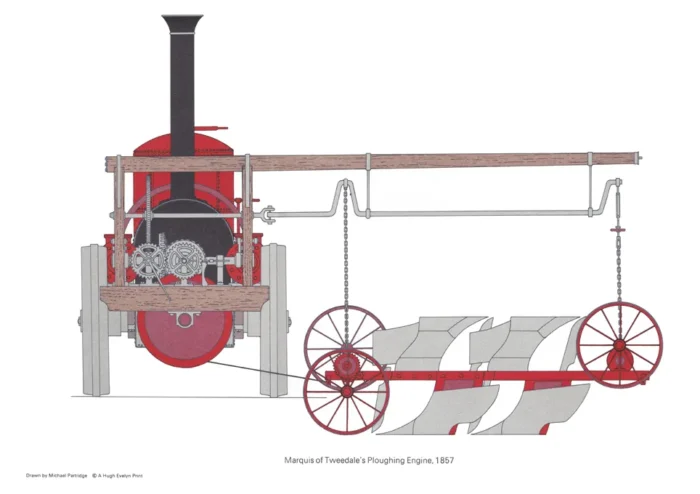Marquis of Tweeddale’s Ploughing Engine, 1857
£20.00
Marquis of Tweeddale’s Ploughing Engine, 1857 (scroll down for a more detailed Description)
Published 1969 by © Hugh Evelyn Limited; drawn by Michael Partridge
Size: 34 x 23 cm [13½″ x 9½″] may vary slightly from printers’ cut 50 years ago
Printed on high white matt heavy paper of 138 g/m2
Print is STANDARD size – shipping is the same for 1 to 10 prints (based on largest print size in your order) – see Shipping & Returns
In stock
Description
Many inventors and engineers attempted to harness the power of steam to the heavy work of ploughing in the early part of the nineteenth century. The Marquis of Tweeddale was one of these and his machinery, made by Tullocks, began operating at about the same time as those of John Fowler, the man who eventually perfected the system. The Marquis’s apparatus used two engines, like Fowler’s. The front wheels could be turned and the drive was provided from the rear wheels. Two ploughing speeds, 3½ and 5 mph, were provided. [The Marquis thought it necessary to clear the land of flints and stubble before ploughing, so invented his horse-drawn subsoil plough]. When the steam plough came within a certain distance of the engine it was lifted clear of the ground by means of a cranked shaft attached to the horizontal beam above the engine. This shaft was moved by engine power and the plough turned over on its axis. Another turn of the crankshaft lowered the plough and positioned it for its return run across the field. Whilst the plough was moving away the engine moved forward 56 inches which was the width of four 14-inch furrows. When moving on the highway the top fixtures and all the accessories were carried on a wagon at the rear of the engine. Fully laden the machine could attain a speed of 4 mph.
Additional information
| Weight | 0.0118 kg |
|---|---|
| Dimensions | 5 × 24.5 cm |





